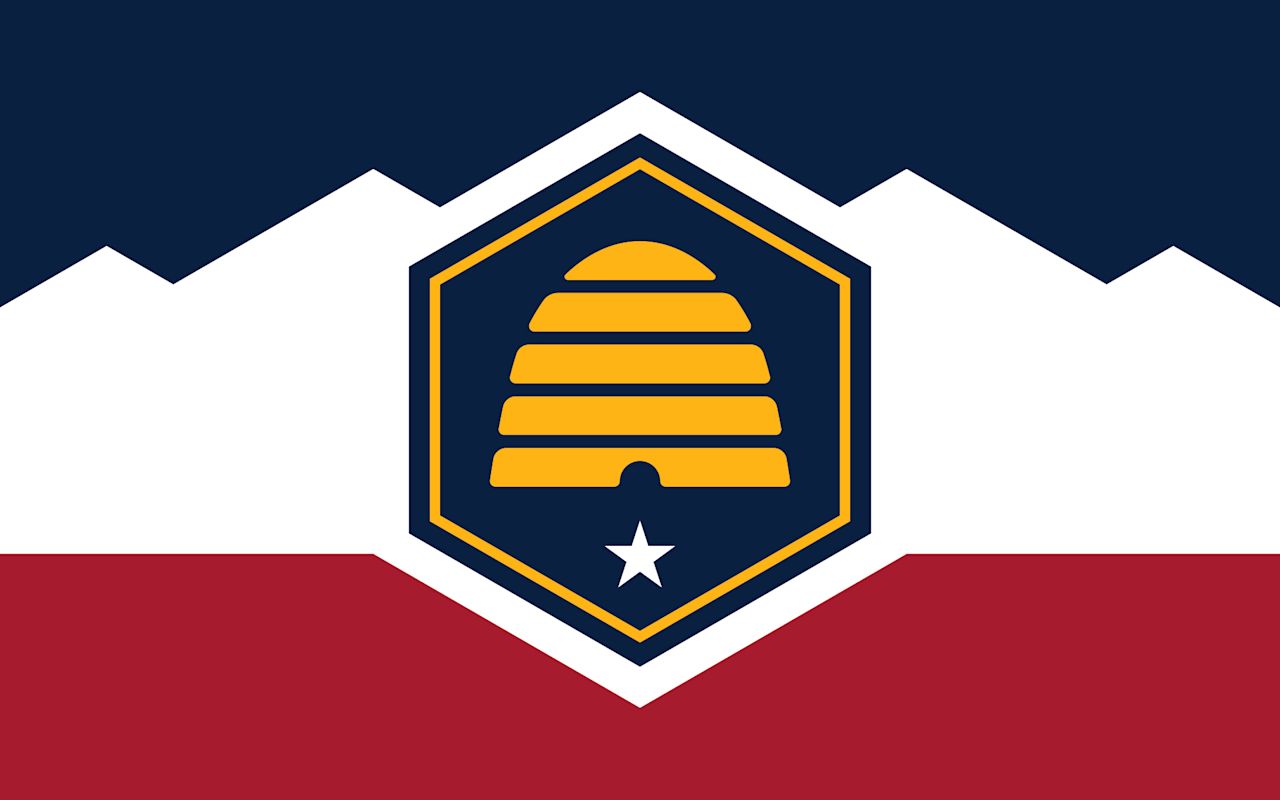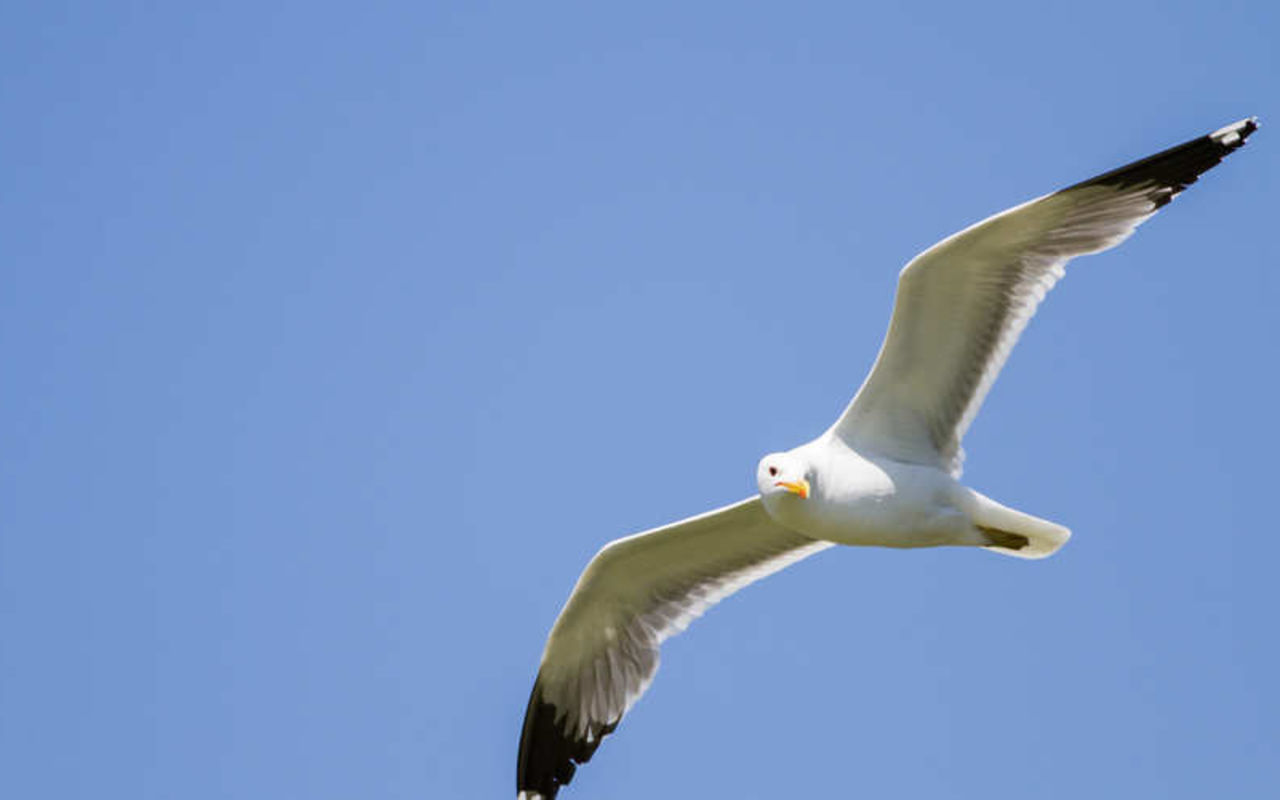State Facts and Symbols
State Facts & Symbols | Photo Gallery


Utah's State Flag
Flag
Utah introduced a brand new state flag in 2023. It was chosen from more than 7,000 designs submitted by the public.
- The blue on top represents Utah's wide open skies and lakes (clever placement), as well core principles such as faith, freedom and optimism. Go big blue!
- The white is meant to evoke peace, as well as make note of our snowy mountain peaks.
- Utah's red rock canyons are represented in the red; it's also a nod to the U.S. flag.
- Honeybees are a big deal here, since they represent industry (because settling a desert is hard work). Thus, the hexagon and beehive.
- Utah was the 45th state to enter the union, so there's a star to represent our loyalty.
BIRD: California Gull
Sort of strange to name the California gull (aka seagull) the state bird of Utah, both because of its non-local name and because it’s a pretty common, plain and scavenge-y bird. (Maybe NFL teams had already claimed all the majestic species …) But it makes more sense when you learn Larus californicus is presumed to be the bird that saved the pioneers’ crops from crickets in 1848–9.
Mormon folklore has it that these gluttonous avian saviors gorged themselves on the Moses-esque plague crickets, overdid it, evacuated themselves from both ends into the Great Salt Lake and then went back for more. Thanks, gross rats of the sky!
FLOWER: Sego Lily
The sego lily (Calochortus nuttallii) is endemic to the western U.S. Like the seagull, it earned its state designation for its service to the early, hungry, cricket-ridden Mormon settlers. (Spoiler alert: Utah’s state insect is not the cricket.) When crops got scarce, Native Americans taught the new arrivals to dig up the sego lily’s nutritious bulbs to stave off starvation. Unlike the seagull, the sego lily is both useful and beautiful.
TREE: Quaking Aspen
The quaking aspen (Populus tremuloides) replaced the blue spruce (Picea pungens) as the state tree in 2014. Fourth graders at Monroe Elementary said the way a colony of aspens grows out of a single root system represents the way Utahns work together to reach new heights. We say that’s anthropomorphic and dismissive of the blue spruce, but we’re sympathetic to their other argument for the change: that quakies are found in all 29 of Utah’s counties and make up 10% of the state’s forest cover, while the blue spruce is primarily limited to the Wasatch and Uinta Mountains and constitutes a mere 1% of total forest cover. Also, Pando.
GEM: Topaz
Topaz is a semiprecious gem found in Beaver, Juab and Tooele counties. It’s an aluminum florisilicate almost as hard as diamonds, and it can be pink, yellow, blue or colorless. In nature, it’s shaped like stubby sharpened pencils. Oh, and it’s the birthstone of November, so if you know a Utahn born that month, you have a doubly perfect gift idea.
ROCK: Coal
Utah officially recognized Coal as the State Rock in 1991. Big coal deposits around the state have given Utahns a lot of electricity, and it even gave Carbon County its name. (Is it possible to long for the day when the state rock is changed to the solar panel, but at the same time give thanks for the coal power and jobs that helped build our state? We think so.)
ANIMAL: Elk
The Rocky Mountain elk (Cervus canadensis , aka Deerus Onsteroidus) became the official state animal in 1971. It used to live throughout the country but over-hunting eradicated populations east of the Rockies. They live alongside deer and moose in most mountain ranges in Utah. Bull elk can reach 700 lbs. and five feet at the shoulder with antlers four feet wide, so remember: It’s the state animal, not the state pet.
FISH: Bonneville Cutthroat Trout
There are 15 recognized subspecies of cutthroat trout (Oncorhynchus clarki), and the Bonneville Cutthroat (Oncorhynchus clarki utah) is ours. It has the characteristic red-orange slash under its jaw and black spots that get more concentrated near the tail. The Bonneville cutthroat was an important food source for Native Americans and early pioneer settlers.
INSECT: Honeybee
Allergic to bees? Hate honey? Take your complaints to the fifth grade glass who successfully lobbied to make Apis mellifera the official insect of Utah in 1983. (They’re in 39th grade now, probably keeping bees in their backyard somewhere in Layton.) Deseret — the name pioneers gave the Utah–Nevada territory before statehood — is a word from the Book of Mormon said to mean honeybee, adding background and an extra layer of connection to state’s emblem (beehive) and motto (“Industry,” i.e. busy and hardworking like a bee).
GRASS: Indian Ricegrass
Oryzopsis hymenoides is a fine, upstanding, non-psychoactive grass. (We all know what Colorado’s favorite grass is…) It’s a hardy species suited to soil types from sand to clay, and Native Americans ground its seeds into meal or flour, especially when the corn crop failed. It’s a helpful deterrent to erosion and makes a good feature in your xeriscaped yard.
MINERAL: Copper
Thirty protons are too many, 28 are too few, we always say. Utah is one of the biggest copper producers in the world. (What’s up, Bingham Canyon Copper Mine? We can CU from space!) We even put a copper top on the Utah State Capitol, so it’ll keep working up to six times longer than regular carbon state capitols.
FOSSIL: Allosaurus
This titan of the late Jurassic was as long and tall as a school bus and weighed more than a ton. Utah has a right to claim it as the state fossil, with an unprecedented (and mysterious!) collection of allosaurus bones discovered at the Cleveland Lloyd Dinosaur Quarry south of Price. Want an awesome visual? Paleontologists have theorized that allosaurus ambushed its prey and used its upper jaw like a hatchet.
FOLK DANCE: Square Dance
Because of course it is.
SONG: “Utah, This Is the Place”
It’s weird, but golldurn if it ain’t catchy.
COOKING POT: Dutch Oven
Didn’t even realize “Official State Cooking Pot” was a thing, did ya? Two words: peach cobbler.
REPTILE: Gila Monster
Again with the kids! Some southern Utah intermediate schoolers managed to convince state leaders an elusive venomous creature is a good way to represent us. 'Cause they're harmless as long as you don't touch them? Anyway, you'll probably never actually see one, since they tend to stay hidden. But if you do, it will likely be in the summer months at the Red Cliffs Reserve in Snow Canyon State Park.